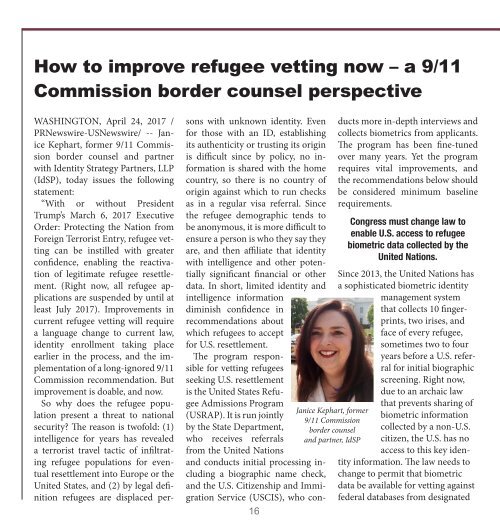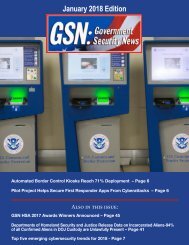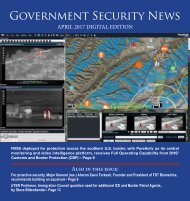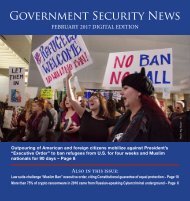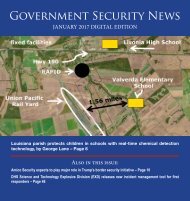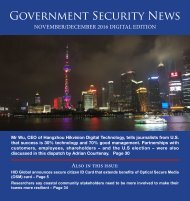GSN_Magazine April Digital Edition
You also want an ePaper? Increase the reach of your titles
YUMPU automatically turns print PDFs into web optimized ePapers that Google loves.
How to improve refugee vetting now – a 9/11<br />
Commission border counsel perspective<br />
Janice Kephart, former<br />
9/11 Commission<br />
border counsel<br />
and partner, IdSP<br />
WASHINGTON, <strong>April</strong> 24, 2017 /<br />
PRNewswire-USNewswire/ -- Janice<br />
Kephart, former 9/11 Commission<br />
border counsel and partner<br />
with Identity Strategy Partners, LLP<br />
(IdSP), today issues the following<br />
statement:<br />
“With or without President<br />
Trump’s March 6, 2017 Executive<br />
Order: Protecting the Nation from<br />
Foreign Terrorist Entry, refugee vetting<br />
can be instilled with greater<br />
confidence, enabling the reactivation<br />
of legitimate refugee resettlement.<br />
(Right now, all refugee applications<br />
are suspended by until at<br />
least July 2017). Improvements in<br />
current refugee vetting will require<br />
a language change to current law,<br />
identity enrollment taking place<br />
earlier in the process, and the implementation<br />
of a long-ignored 9/11<br />
Commission recommendation. But<br />
improvement is doable, and now.<br />
So why does the refugee population<br />
present a threat to national<br />
security? The reason is twofold: (1)<br />
intelligence for years has revealed<br />
a terrorist travel tactic of infiltrating<br />
refugee populations for eventual<br />
resettlement into Europe or the<br />
United States, and (2) by legal definition<br />
refugees are displaced persons<br />
with unknown identity. Even<br />
for those with an ID, establishing<br />
its authenticity or trusting its origin<br />
is difficult since by policy, no information<br />
is shared with the home<br />
country, so there is no country of<br />
origin against which to run checks<br />
as in a regular visa referral. Since<br />
the refugee demographic tends to<br />
be anonymous, it is more difficult to<br />
ensure a person is who they say they<br />
are, and then affiliate that identity<br />
with intelligence and other potentially<br />
significant financial or other<br />
data. In short, limited identity and<br />
intelligence information<br />
diminish confidence in<br />
recommendations about<br />
which refugees to accept<br />
for U.S. resettlement.<br />
The program responsible<br />
for vetting refugees<br />
seeking U.S. resettlement<br />
is the United States Refugee<br />
Admissions Program<br />
(USRAP). It is run jointly<br />
by the State Department,<br />
who receives referrals<br />
from the United Nations<br />
and conducts initial processing including<br />
a biographic name check,<br />
and the U.S. Citizenship and Immigration<br />
Service (USCIS), who conducts<br />
more in-depth interviews and<br />
collects biometrics from applicants.<br />
The program has been fine-tuned<br />
over many years. Yet the program<br />
requires vital improvements, and<br />
the recommendations below should<br />
be considered minimum baseline<br />
requirements.<br />
Congress must change law to<br />
enable U.S. access to refugee<br />
biometric data collected by the<br />
United Nations.<br />
Since 2013, the United Nations has<br />
a sophisticated biometric identity<br />
management system<br />
that collects 10 fingerprints,<br />
two irises, and<br />
face of every refugee,<br />
sometimes two to four<br />
years before a U.S. referral<br />
for initial biographic<br />
screening. Right now,<br />
due to an archaic law<br />
that prevents sharing of<br />
biometric information<br />
collected by a non-U.S.<br />
citizen, the U.S. has no<br />
access to this key identity<br />
information. The law needs to<br />
change to permit that biometric<br />
data be available for vetting against<br />
federal databases from designated<br />
international partners such as the<br />
United Nations.<br />
Refugees must be biometrically<br />
enrolled the first time they enter the<br />
U.S. system.<br />
State does not collect any biometrics<br />
from refugees, and thus only<br />
has the word of the refugee as to<br />
who they are, making the required<br />
biographic checks a potential goose<br />
chase. While USCIS does collect<br />
rolled prints and a face photo at the<br />
time of the interview, current vetting<br />
against some U.S. biometric<br />
holdings do not return results for<br />
up to 24 hours, after the interview<br />
is already over. If State collected<br />
the biometrics as part of their prescreening<br />
interviews conducted<br />
by their Resettlement Service staff,<br />
USCIS interviews would be better<br />
informed, and so would the final assessment.<br />
Implement the 9/11 Commission<br />
recommendation for a<br />
person-centric immigration system.<br />
State and USCIS use different case<br />
filing assignments for refugees.<br />
Policy does not require that State<br />
initiate a file number that USCIS<br />
recognizes or uses in the processing<br />
of the ultimate immigration benefit<br />
the refugee seeks. Thus, each applicant<br />
has two different file numbers,<br />
creating disconnect and potential<br />
for confusion and duplication. Yet<br />
Pelco showcases latest<br />
technology innovations and<br />
strategic application solutions<br />
Continued from page 11<br />
ExSite Enhanced HD Cameras<br />
are explosion proof and virtually<br />
indestructible with performance<br />
features that include: a robotically<br />
welded housing for use in extreme<br />
conditions; a unique patent-pending<br />
pan-tilt drive system devoid of<br />
belts, gears or pulleys; operation in<br />
the problem could be eliminated<br />
entirely if case numbers were eradicated<br />
and the 9/11 Commission<br />
recommendation for a biometricbased<br />
identity number for the entire<br />
immigration system were put in its<br />
place. When biometrics become the<br />
baseline for any immigration encounter,<br />
identity is protected and<br />
the automatic creation of a timeline<br />
of immigration encounters reduces<br />
fraud and increases efficiencies for<br />
legal immigration. Implementation<br />
of this long ignored 9/11 Commission<br />
recommendation could drastically<br />
improve the U.S. immigration<br />
system, and with it, refugee vetting<br />
as it stands today.”<br />
Contact: Janice Kephar , (202) 750-<br />
4858, SOURCE Identity Strategy<br />
Partners (IdSP)<br />
16 17<br />
extreme temperatures; 30X optical<br />
zoom with image stabilization; IR<br />
illumination; 130dB WDR; 0.03 lux<br />
ultra-low light performance; integrated<br />
Ethernet, fiber, Ethernet over<br />
Coax (EoC) and Unshielded Twisted<br />
Pair (UTP) transmission, and<br />
more. ExSite is an exceptional imaging<br />
solution for oil and gas facilities,<br />
chemical plants, manufacturing and<br />
marine facilities, and for numerous<br />
other demanding environments.<br />
For more information or to schedule<br />
a demo, contact evgeni.tochev@<br />
schneider-electric.com or visit www.<br />
pelco.com.<br />
About Pelco by Schneider Electric<br />
Pelco by Schneider Electric is a<br />
global leader in professional video<br />
surveillance and security system<br />
products and technologies with<br />
a local presence in 136 countries<br />
and over 4000 integration partners<br />
worldwide. Our personal engagement<br />
with customers, resellers and<br />
technology partners drives the development<br />
and deployment of surveillance<br />
and security solutions<br />
with meaningful innovation. It’s the<br />
foundation that Pelco has built its<br />
brand upon for over 25 years.


